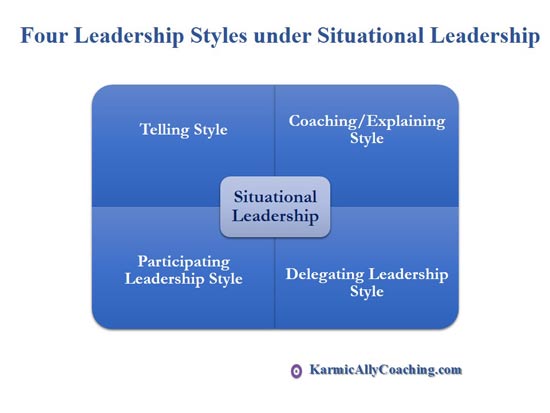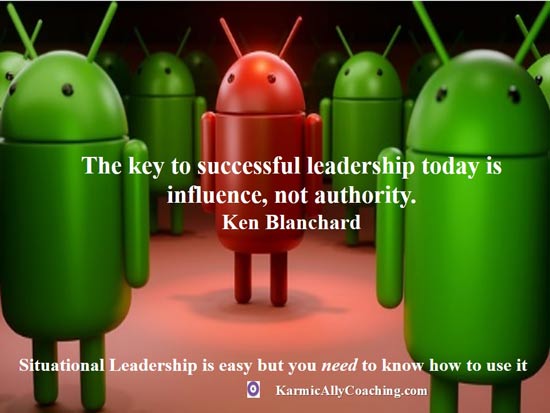This post has already been read 753 times!

Situational Leadership isn’t a new concept but its importance is becoming relevant to meet the demands of an increasingly diverse society and corporate workplace. Especially in the pandemic world.
A one-size-fits-all leadership style doesn’t meet the demands or requirements while Situational leadership offers a more flexible solution.
Back in my auditor days, our audit teams often had professionals from other departments like tax and IT join us for major audits. Our job on these particular areas was to do a broad overview and complete checklists to enable them to do more in-depth work.
Risk management and compliance required them to review systems and other important areas enabling us to prepare our audit reports which the audit partner could sign off on as being true and fair.
The Audit Manager had to ensure a smooth running of this complex team with different skill sets, temperaments and requirements.
Quite often the outside team members would be of different experience levels and required a supervisor or manager to help them get the required information from the client.
Getting the team to work as one could be challenging at times when there were diverse specialists.
In modern businesses, especially multinational companies, one finds different teams from different backgrounds and cultures. Dealing with these diverse groups sometimes means switching one’s leadership approach.
This is why many business leaders are embracing situational leadership as a management style and its growing popularity.
A good leader knows how to achieve organization goals while also helping their teams achieve their own goals. This leadership style facilitates it.
Sociology textbooks explain how various researchers have contributed in this area, but the concept is relatively straightforward.
Instead of sticking with what you know, you adapt your leadership style to different circumstances.
That’s a simple explanation of Situational Leadership.
The origins of Situational Leadership Styles
This leadership style was first described by Paul Hersey and Ken Blanchard in their 1969 book, Management of Organizational Behavior. Originally called the “Life Cycle Theory of Leadership,” several years later they renamed it “situational leadership theory”.
Hersey and Blanchard each developed individual theories based on the initial concept of situational leadership, which they further described in their books, The Situational Leader (Hersey 1985) and The One-Minute Manager (Blanchard 1982) and Leadership and the One Minute Manager Updated Ed: Increasing Effectiveness Through Situational Leadership II (Blanchard 2013).
The basic concept behind a situational leadership style is that the leader changes their approach to leadership based on the needs of the moment, hence the term “situational.”
It’s the opposite of one size fits all. Some employees or team members are proficient at their work and can take more responsibility.
You can delegate tasks and do a periodic check-in while you might need to manage a junior team member more with a focus on clearly defined tasks and deadlines.
Because no two situations are the same, the situational leadership style borrows from many other leadership styles to find the right approach based on the circumstances and situation.
Four Leadership Styles under Situational Leadership

Briefly, these 4 leadership styles come under the umbrella of situational leadership. A good leader will use the required style depending on the situation.
Telling style
Short-term approach designed to create movement in the employee with the approach to leading others adjusted based on the needs of the moment.
This style works best when a manager needs to get the best results from a group with a lesser skill set. It involves a high amount of supervision from managers, and it’s much more focused on completion of tasks than boosting the relationship and psychological safety between manager and employee.
It’s the most autocratic of the styles and is commonly seen in military situations.
Coaching or explaining style
Intended to create buy-in and understanding. It puts the leader in more of a coaching role than a directing one and sports organizations commonly use this style.
It aligns with followers with limited experience performing the task but exude both confidence and motivation toward the process of leader-driven skill development.
The leader’s job is to make sure tasks go to those best suited to the job while providing advice and experience.
Participating leadership style
This is a democratic approach and used to create alignment. It is best suited for teams with high skill sets where the leader provides more feedback than guidance.
It is a good style to help junior managers develop their own leadership skills.
Delegating leadership style
Designed to create autonomy at the employee level and let employees run with their own projects. It works well for staff with high skill levels and is the most hands-off approach of all 4 styles.
In this case, the leader oversees the work while ensuring things go according to plan. It’s an ideal approach when working with senior team members.
Whichever leadership style is adopted to match the situation, the leader clearly exercises influence and needs to choose the right style to be effective.
If you want to develop your own situational leadership style, then this 2 step approach will provide you with the required guidance to take informed decisions.
Two Step Approach to applying Situation Leadership
Step 1 – Assessing the Situation
There are many factors to take into account when you’re working with a group, especially the nature of your team and what you’re trying to accomplish.
Keep these tips in mind:
- Evaluate engagement. Willingness and enthusiasm are two key qualities to look for. Some obvious signs of employee engagement include exceeding expectations and spending time on professional development activities.
- Measure ability. In addition to willingness, your team must also be able to do the required tasks. You may want to administer tests or ask for self-assessments.
- Explore personalities. Understanding personalities matters too. Talking about values and work styles can help you to figure out how to motivate your team and handle conflicts.
- Clarify expectations. Lay down some ground rules and work at developing group and individual goals. Put your principles and objectives down in writing.
- Define tasks. Consider the nature of your work. Is it mostly simple and routine or does it involve more complex reasoning and variety?
- Meet deadlines. Keep your timeline in mind. Will you need to make decisions on your own quickly or is there more room for discussion and consultation?

Step 2 – Understanding Your Options
As we learned earlier, there’s no one-style-fits-all style of leadership. In order to be influential and effective, you need to expand your leadership skills.
This will prepare you for a range of opportunities that you’re likely to come across in today’s workplace.
Depending on the situation, various strategies may be effective, such as:
- Provide direction. Sometimes leadership boils down to giving instructions. That may be the case if your team is limited in terms of willingness or ability.
- Offer coaching. At the same time, you may be able to offer more support and less direction as your team acquires greater experience and forms stronger relationships. Create a culture of constructive feedback, high standards, and ongoing learning.
- Delegate responsibility. Identify which tasks you need to do yourself and which you can hand over to someone else. This may include recurring activities or those that give employees a chance to upgrade their skills.
- Earn trust. Even if your role carries a high level of authority, it’s beneficial to build trust. A team is more likely to succeed if they feel secure and respected. Strive to be consistent and objective. Communicate openly and take responsibility for your decisions.
- Set an example. What does your behavior say about your character and abilities? Your team will notice what you do as well as what you say. Honor your commitments and work on your listening skills.
- Build personal relationships. Meaningful connections and shared goals turn a group of individuals into a team. As a leader, it’s important to establish rapport and show appreciation. Stay positive and approachable.
- Identify talent. Who are the shining stars on your team? Create future leaders by spotting talent and nurturing it. Pay attention to potential along with current performance, so you’ll be prepared for emerging needs and opportunities.
Successful leaders keep growing and applying what they learn.
Developing your situational leadership skills can help you to advance your career, while you help increase productivity and morale.
Is this an area you already know you need to develop?
If yes, then get Karmic Ally Coaching’s Influential Leader Crash course here or click the image below for more information.
Do you have experience with using situational leadership in your organisation?





 I adhere to the Certified Coaches Alliance Code of Ethics and Standards. A copy is available on request.
I adhere to the Certified Coaches Alliance Code of Ethics and Standards. A copy is available on request.
 Let's Talk through the Connect Form:
Let's Talk through the Connect Form: